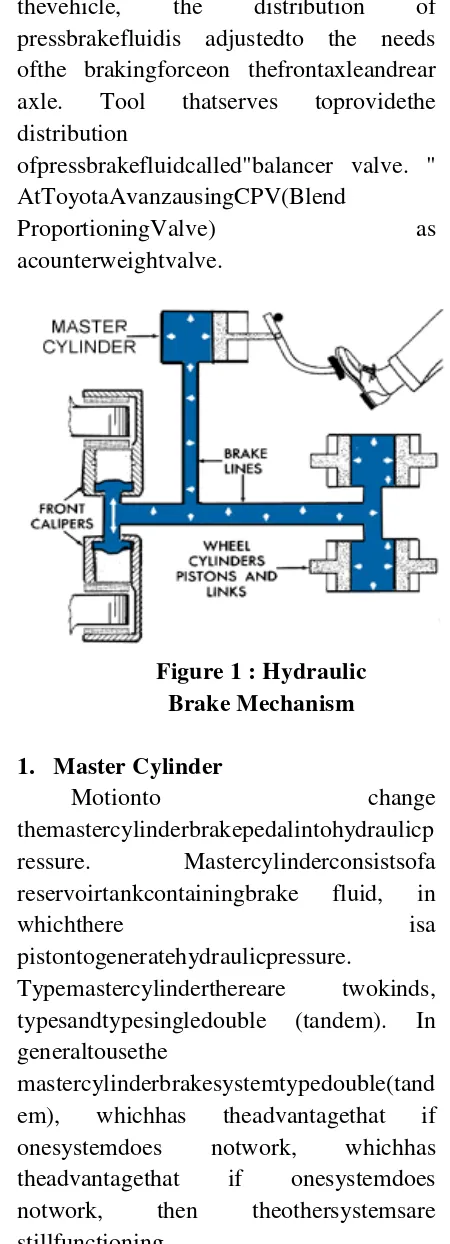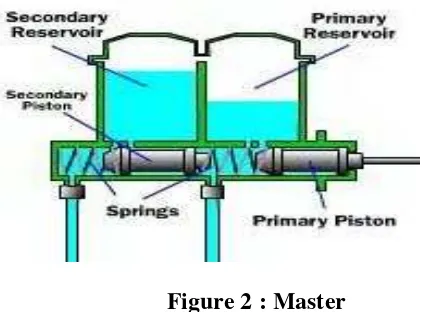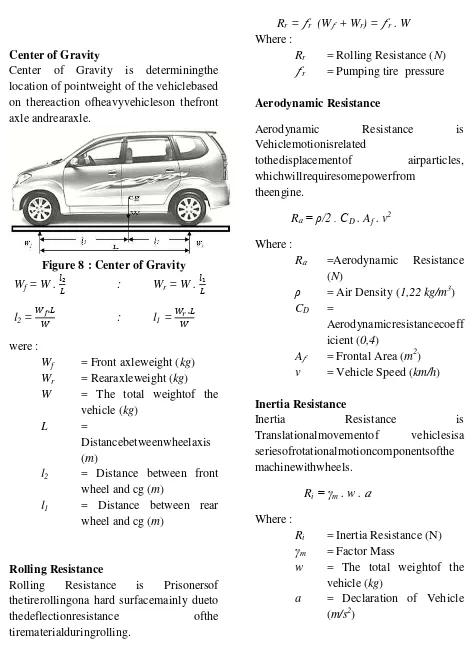ANALYSIS OF MAXIMUM BRAKING FORCE DISC
BRAKE AND DRUM BRAKE ON TOYOTA AVANZA
G 1.3 M/T
PUBLICATION ARTICLE
Submitted as a Partial Fulfillment of the Requirements for Getting Bachelor Degree of Engineering in Uutomotive Departement
Arranged by :
Amar Makruf
D 700 070 009
MECHANICAL ENGINEERING DEPARTMENT
INTERNATIONAL PROGRAM
IN AUTOMOTIVE/MOTORCYCLE ENGINEERING
MUHAMMADIYAH UNIVERSITY OF SURAKARTA
ANALYSIS OF MAXIMUM BRAKING FORCE DISC BRAKE AND DRUM BRAKE ON TOYOTA AVANZA G 1.3 M/T
Ir. Pramuko IP, MT
Automotive Department of Muhammadiyah University of Surakarta Jln. A. Yani Pabelan-Kartasura. Tromol Pos I Telp. (0271) 715448, Surakarta
Wijianto, ST. M. Eng. Sc
Automotive Department of Muhammadiyah University of Surakarta Jln. A. Yani Pabelan-Kartasura. Tromol Pos I Telp. (0271) 715448, Surakarta
Amar Makruf
Automotive Department of Muhammadiyah University of Surakarta Jln. A. Yani Pabelan-Kartasura. Tromol Pos I Telp. (0271) 715448, Surakarta
Email: gutenaben@gmail.com
ABSTRACT
Brakes are a vital part of the vehicle, which serves to slow or stop the vehicle. There are various types of brakes that have the characteristics of each. Author of this final goal is to assess vehicle brake problems Toyota Avanza G 1.3 M / T. the use of disc brakes (ventilated disc) on the front wheel and brake drum (leading-tailing) on the rear wheels. The objective to determine themaximumbrakingcapacity ofthefront axle andrearaxlewiththevehiclespeed difference.
Analysisdoneby changingthe speed ofthe vehicle speedbut withthe samestoppingdistance which one the variation of speed 50 km/h, 55 km/h, 60 km/h, 80 km/h, 100 km/h and the stopping distance is 50 meter.
From thecalculation ofthe dynamics ofvehiclebraking, it was found thatToyota Avanzavehiclesat speeds100 km/h the deceleration is 7,743 m/s2 providebraking forceis 10.457,379N on thefront axleand thebraking forceis 5.211,024N on therearaxle, at speeds80 km/h the deceleration is 4,928 m/s2 providebraking forceis 9.636,898N on thefront axleand thebraking forceis 4.505,004N on therearaxle. at speeds60 km/h the deceleration is 2,751 m/s2 providebraking forceis 9.002,444N on thefront axleand thebraking forceis 3.866,09N on therearaxle. at speeds55 km/h the deceleration is 2,310 m/s2 providebraking forceis 8.873,968N on thefront axleand thebraking forceis 3.682,31N on therearaxle, at speeds50 km/h the deceleration is 1,904 m/s2 providebraking forceis 8.755,632N on thefront axleand thebraking forceis 3.553,834N on therearaxle. Braking forceis avehiclebrakingforceneedsto be metby thebrakeunitcontainedin vehicle.
Background
Themost
importantfactorindrivingsafetyis aneed foraneffectivebrake.
timewithoutreducing thebrakingstability ofthe vehicle.
Brakeisadeviceona carthat servestoreduceorstop thespeed ofthe car. Brakesareavitalsafetyequipment,
becauseitbrakesmusthaveaperfectconstructi on, it can work well, toensurethe securityanddurabilitythatcanhavereliability.
In addition,the
brakecanalsobecheckedandadjustedwith relative ease.
Brakeequipmentinstalledat thewheel ofa car. The principleisto change thebrakesorbrakingkineticenergy(motion)
intoheat energyby
havingafrictionsurfacemadeoftwoobjects. Types ofbrakesin general can beclassifiedaccording toshapeand constructionaccording tothe mechanism ofmovement. According toitsform ofconstruction, among others, havedisc brakesanddrumbrakes.
Meanwhile,according tothe mechanism ofmovementamongother things,the mechanicalbrake, hydraulicbrakes, airbrakes, andothers.
Inacarusuallycontain oftwokinds
ofbrakesystems, that
arehydraulicsystemsandmechanicalsystems .
Hydraulicsystemmountedonallwheelsandus ed asthe mainbrake, whichatthe timethe carisinrunningcondition.
Mechanicalbrakesystemisonlymountedonth e rear wheelsandinuseat thetimethecarisstoppingorparkingsituation.
In
thepassengercarbraketypecommonlyinusef orthe front wheelis atype ofbrakediscandtothe rear wheelsinusetype ofdrumbrakes. There is atendencyforthe
carsnowmake use ofthe
brakediscsonallwheels, especiallyin thesedanclass.
Newvehicleshavestandardbrakeequip mentthathasagoodperformance.
Butifitisnotfollowedbyproperandregularma intenance,
brakeperformancewilldeteriorate. Thiswill be feltonce duringbrakingdemandis expected, such as :
- braking time is too slow, where the vehicle can not stop quickly. - Inequalitybraking
forceateachwheelso that theresultingdecreasevehicle stability. Because ofthe importance ofthisproblemwillbrake,
thenperiodicallyOfficeof
TrafficandTransportation(DLLAJ)
conductinspectionsanddue diligence, including thetestforvehiclebraking.
Throughthis research, the authorswanted toanalyzethe influence ofthe speed ofthe vehicle speedwhichcauses themaximum braking force capacity.
Problem Statement
vehiclewhendriving atdifferent speedsbut withthe samestoppingdistanceandthe effect ofmaximum braking force capacity on the front axle and rear axle.
Objective
The purpose of this study is to investigate themaximumbrakingForce ofthefront brake and rear brake on Toyota Avanza G 1.3 M/T with vehicle speed of 50 km/h, 55 km/h, 60 km/h, 80 km/h 100 km/h.
Problem Limitation
Vehiclesthatwill bestudiedis thetype ofpassengercarisToyotaAvanza1.3G
M/TAnalysis ofthe dynamics ofbrakingat thelimitofbrakingconditionsasfollows: namelywhen thecompression forcewhichis giveninaclosedsectionofthe fluidwillbe forwardedtoall directionsequally. Buton
thevehicle, the distribution of pressbrakefluidis adjustedto the needs ofthe brakingforceon thefrontaxleandrear axle. Tool thatserves toprovidethe distribution
ofpressbrakefluidcalled"balancer valve. " AtToyotaAvanzausingCPV(Blend
ProportioningValve) as
acounterweightvalve.
Figure 1 : Hydraulic Brake Mechanism
1. Master Cylinder
Motionto change
themastercylinderbrakepedalintohydraulicp ressure. Mastercylinderconsistsofa reservoirtankcontainingbrake fluid, in
whichthere isa
pistontogeneratehydraulicpressure.
Typemastercylinderthereare twokinds, typesandtypesingledouble (tandem). In generaltousethe
Figure 2 : Master Cylinder
2. Proportioning Valve
In the vehicle in front engine, front generally more severe than on the back. When the vehicle brakes, then the center of gravity will move forward. This is caused because the force of inertia and load transfer to the front. When the same braking traction of the four wheels, the rear wheels will lock that caused the slip between tire and road surface, causing the vehicle difficult to control. Therefore, the necessary equipment divider brake fluid pressure to obtain a balanced braking force between front wheels and rear wheels. The tool is called a "counterweight valve" that works automatically to provide a balanced braking force between front wheels and rear wheels.
Figure 3 : Proportioning Valve
3. Brake Pipe And Hoses
Brakelineis partof
thehydraulicbrakesystemin the formofsteelpipethatservesas a means oftransportation
ofbrakefluidfrommastercylindertowheelcyl inder/caliper.
Figure 4 : Brake Hoses 4. Brake Fluid
Brakefluidservesas
atransportationenergyisenergypressure. Inuse, the brakefluidmustmeetcertain standards.Those standardshave beendeterminedby
Allbrakefluidis producedunderthe provisions ofSAEandDOT.
Figure 5 : Brake Fluid
Brake Unit
Brake systems on vehicles are divided into 3 types: namely, disc brakes,
brake drums, and a combination of disc-drum brakes. Toyota Avanza use the brake type of ventilated disc brakes on front wheels and drum brakes on rear wheels.
Figure 6 : Disc Brake and Drum Brake
RESEARCH METHODOLOGY Flowchart of Research
Figure7 : Flow Chard of Research
Data
Calculation Analysis and Discussion
Conclusion
End
v = 50 km/h v = 55 km/h v = 60 km/h v = 80 km/h v = 100 km/h
Data Study Review of Literature
Center of Gravity
Center of Gravity is determiningthe location of pointweight of the vehiclebased on thereaction ofheavyvehicleson thefront axle andrearaxle.
Figure 8 : Center of Gravity
Wf = W . : Wr = W .
Rolling Resistance is Prisonersof thetirerollingona hard surfacemainly dueto thedeflectionresistance ofthe tirematerialduringrolling.
Aerodynamic Resistance is Vehiclemotionisrelated
tothedisplacementof airparticles, whichwillrequiresomepowerfrom
theengine.
R�= ρ/2 . CD . Af . v2
Where :
R� =Aerodynamic Resistance (N)
Inertia Resistance is
Analysis of Braking Force at the Toyota Avanza
Maximumbrakingonfront axle andrearaxleis :
100 km/h 80 km/h 60 km/h 55 km/h 50 km/h
Wbf 13.071,724N 12.046,123N 11.253,056N 11.092,461N 10.944,566N
Wbr 6.513,781 N 5.631,256 N 4.832,613 N 4.602,888 N 4.442,293 N
Fbf max 10.457,379N 9.636,898 N 9.002,444 N 8.873,968 N 8.755,632 N
Fbr max 5.211,024 N 4.505,004 N 3.866,09 N 3.682,31 N 3.553,834 N
Graph1 : is agraphofmaximum braking forceonfront axle.
Graph abovewecan analyzethat in thevehiclewith a speedof 50 km/h willrequiremaximum braking forceof8.755,632Nandat a speed of55 km/h willrequiremaximum braking forceof8.873,986Nandat a speed of60 km/hwillrequiremaximumbraking
force9.002,444Nandat a speedof 80 km/h willrequiremaximum braking forceof9636.898Nandat a speed of100 km/h willrequiremaximumbraking force10.457,379N,
Vehicle Speed (km/h)
F
bf maxGraph2 : is agraphofmaximum braking forceonrear axle.
Graph abovewecan analyzethat in thevehiclewith a speedof 50 km/h willrequiremaximum braking forceof3.553,834Nandat a speed of55 km/h willrequiremaximum braking forceof3.682,31Nandat a speed of60 km/hwillrequiremaximumbraking
force3.866,09Nandat a speedof 80 km/h willrequiremaximum braking forceof4.505,004Nandat a speed of100 km/h willrequiremaximumbraking force5.211,024N,
andthemajorforceinneedbybrakingon therear axle.
Conclusions
From the analysisand calculation oftheresultingconclusionsfrom
thecalculation ofthe dynamics ofvehiclebraking, it was found thatvehiclebrakingcapacityontoyotaavanza, the highervehicle speed, the bigger brakingcapacityneededin
frontaxleandrearaxle.
Suggestions
Inthis thesis, the authorhad the opportunityto givesuggestionsinclude :
1. Properand
regularmaintenanceshould beperformedowners/users of vehiclesin order toget aperformancevehicle thatever fit.
2. The occurrence ofwheel lockduringbrakingmustbe avoided, because it causesthe vehicledifficult to controlandthis willendanger the safetyduringdriving.
For thatdeviceABS(anti lock braking system) is necessaryfor safety and comfortof vehicles.
5,211.02
Vehicle Speed (km/h)
F
br max3. Excessiveheatduringbrakingmu stbe avoidedbecause it cancausefading(the decrease brakeperformancedue
toexcessiveheat generated)
4. For a discussionthat willcometo
bebetterin the
searchdataanddeepeningthe
theoryin order
tofacilitatediscussionandobtainb etter results.
REFERENCES
Artmonov, M.M.Morin. 1976. Motor vehicle Fundamental and Design. Moscow. Mir Poblisher.
Bagyo S, Drs. Darmanto, Drs. Soemarsono, B.Sc. 1997. Otomotif mesin tenaga, Tiga Serangkai
Gillespie, Thomas D. 1994 . Fundamentals of Vehicle Dynamics. 400 Commonwealth Drive Warrendale. Society of Automotive Engineer.
J.Y. Wong. 2001. Theory of Ground Vehicle, A Willey Interscience Publication, Canada Khurmi, R. S. Gupta. JK, 1982Toyota 1992. Pedoman Reparasi Chasis dan Body Kijang.
Jakarta PT. Toyota Astra Motor.
Niemenn, G. Machine Element Design and Calculation in Mechanical Engineering. Vol II. Springer Verlag. Berlin.
M. Suratman. Auto Mobil. 2001 . Pustaka Grafika.
Sularso, Ir.MSME. Kiyokatsu Suga. Perencanaan dan Perencanaan dan Pemilihan Elemen Mesin. PT. Pradaya Paramita.



